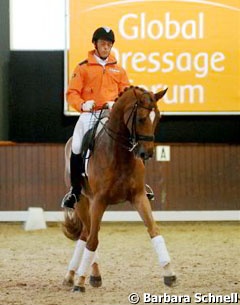
It is a pity that so few Germans made their way to the eighth Global Dressage Forum at the Bartels family's equestrian centre in Hooge Mierde, The Netherlands. The Forum is very easy to reach from Germany and it is surprising that no Germans felt the need to participate
in the almost provocatively sounding central topic of this year's Forum: Dutch Dressage. The theme revealed some approaches from which the sport in general could profit, but also some weaknesses which were not openly discussed at the event.
Fifteen Dutch bred horses - ranging from 4-year old youngsters to Laurens van Lieren's championship horse Ollright - and their riders demonstrated a system with riding that showed much more ambition than what is prescribed in Germany for the training of young horses. The Dutch warmblood society (KWPN) and the Dutch Equestrian Federation (KNHS) work hand in hand to build up a solid program for the future. This program has already proved its worth many times.
In Holland you have the Pavo Cup for 4 and 5-year olds, which do not have to ride a fixed test like at the German Bundeschampionate. In The Netherlands the youngsters have to show their abilities in a relaxed frame. Of course it is a fact that judging can't happen according to strict training criteria if you don't ride a technical test and it showed that riders can meddle with the current training level of the presented horses.
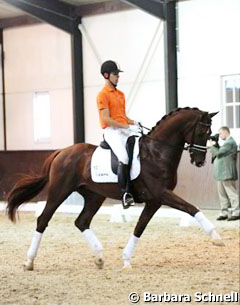 On the other hand, young horses which are pushed to fit into a show schedule, are not always judged in the Pavo Cup series. Here they are judged according to potential and mistakes are not really taken into account.
On the other hand, young horses which are pushed to fit into a show schedule, are not always judged in the Pavo Cup series. Here they are judged according to potential and mistakes are not really taken into account.
The second pillar of Dutch Dressage is the 2002 founded Rabobank Talent Plan for the scouting of talented youth riders. Every year in the autumn the KNHS selects the best 120 riders out of a group of 300, who are accepted for a winter training program and trained with competition sport as goal. Once more the Dutch team spirit surfaces, which the orange riders show so often at competitions. Not only do national team trainers track potential stars, but also top riders such as Anky van Grunsven participate in the program and teach at training sessions.
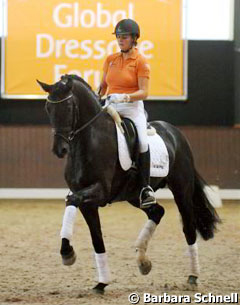 This Talent scouting is still not functioning at an optimal level, which hostess and Dutch junior rider chef d'equipe Tineke Bartels admitted. But the Federation continues to work at improving the system and make sure that the best horses are paired to the best riders. Good examples are Hans Peter Minderhoud and Vivaldi or Laurens van Lieren with Hexagons Ollright: quality KWPN horses matched with professional riders.
This Talent scouting is still not functioning at an optimal level, which hostess and Dutch junior rider chef d'equipe Tineke Bartels admitted. But the Federation continues to work at improving the system and make sure that the best horses are paired to the best riders. Good examples are Hans Peter Minderhoud and Vivaldi or Laurens van Lieren with Hexagons Ollright: quality KWPN horses matched with professional riders.
In the slipstream of all this comes a phenomenon: the so called Anky-faktor. In The Netherlands Anky van Grunsven is a super star, which is hardly imaginable for a German top rider. And the KNHS makes use out of her popularity, as she always commits herself to putting young riders in the spotlight alongside her, when she is featured on television. Like this she attracts potential sponsors for them.
"Of course every rider fulfills his own interests," Tineke Bartels confirmed, "but they all have the same goal, to do something for the sport. And that's what we are working on."
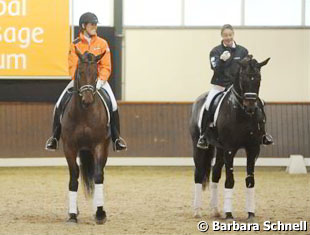 The KNHS also stressed the co-operation between the individual trainers of each rider and the national team trainers. Furthermore, the federation is also doing something about the judging. They want to prevent shows appointing their own judges and instead set up a central system, which sends out different judges to shows, so that the young judges get more chances to work themselves to a higher level.
The KNHS also stressed the co-operation between the individual trainers of each rider and the national team trainers. Furthermore, the federation is also doing something about the judging. They want to prevent shows appointing their own judges and instead set up a central system, which sends out different judges to shows, so that the young judges get more chances to work themselves to a higher level.
The explanation of this Dutch system by delegates of the KNHS and KWPN (unfortunately the KWPN official was not very fluent in English) was impressive and its demonstration would have been perfect were there not some horses shown in a tight frame and not working from behind. The nicest pair in the ring was without a doubt Rabobank Talent Team member Diederik van Silfhout who presented the licensed stallion Rhodium in the right frame with good relaxation.
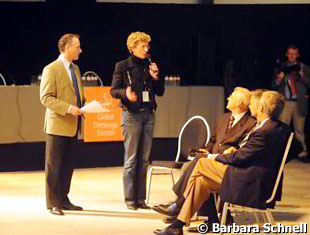 A standard section at each Global Dressage Forum is the assessment of the judging at that year's biggest championship and in this case, the 2008 Olympic Games. This session featured O-judges assessesing certain movements in an Olympic test, but in general the talk was bland and uninspiring. The analyses of individual notes of two Grand Prix Special riders (Alexandra Korelova/Balagur and Steffen Peters/Ravel) left the audience in doubt and frustrated. No one in the audience was spurred to question the notes the judges gave for one transition (8-6-5-6-8) and FEI Dressage representative Mariette Withages short circuited any debate by stating: "the judging was good and the press, which thinks otherwise, is wrong."
A standard section at each Global Dressage Forum is the assessment of the judging at that year's biggest championship and in this case, the 2008 Olympic Games. This session featured O-judges assessesing certain movements in an Olympic test, but in general the talk was bland and uninspiring. The analyses of individual notes of two Grand Prix Special riders (Alexandra Korelova/Balagur and Steffen Peters/Ravel) left the audience in doubt and frustrated. No one in the audience was spurred to question the notes the judges gave for one transition (8-6-5-6-8) and FEI Dressage representative Mariette Withages short circuited any debate by stating: "the judging was good and the press, which thinks otherwise, is wrong."
It was Heike Kemmer who saved the day of the judging session by commenting on her own ride in Hong Kong. Her funny remarks on her test and others as well as the big smile that appeared on her face watching her Olympic ride were infectuous. It transcended the narrowmindedness and defensiveness of some of the judges on the GDF panel.
Text and photos by Barbara Schnell
Back to the 2008 GDF index